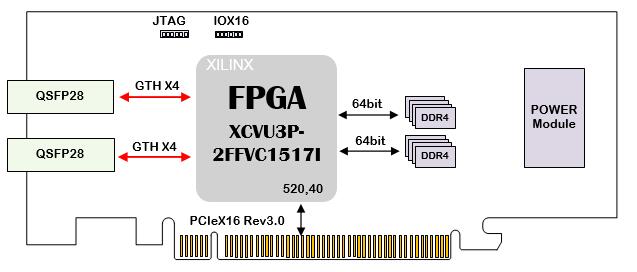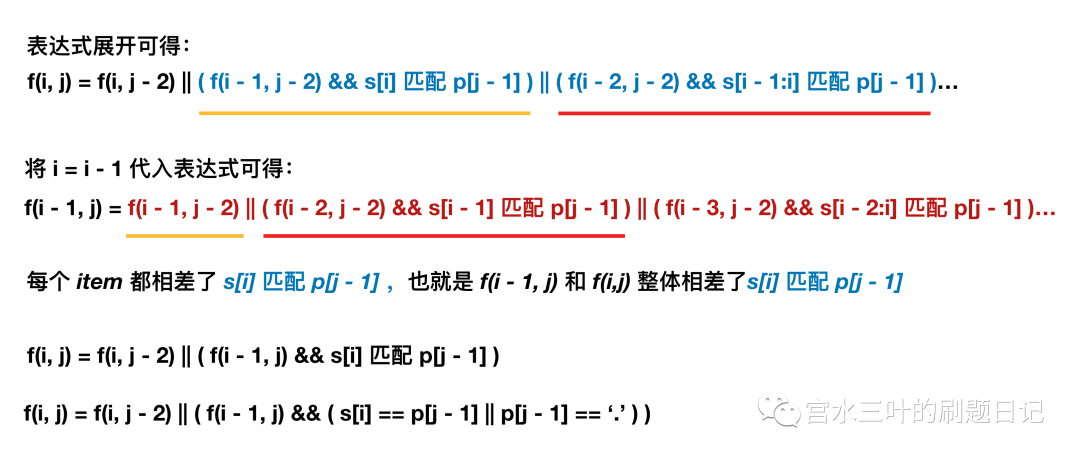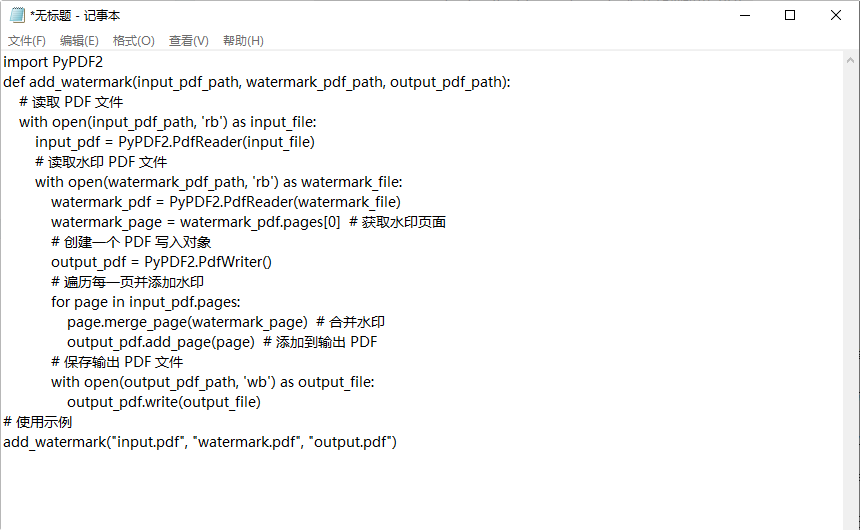黑马程序员C++核心编程学习笔记
一、内存
1.1 内存四区
C++程序在执行时,将内存大致分为4个区域:代码区,全局区,栈区,堆区
-
代码区:存放函数体的的二进制代码,操作系统管理。
🔵特点:①共享 :对于频繁被执行的程序,只需要在内存中有一份代码即可。
②只读:目的是防止程序意外地修改了它的指令。 -
全局区:存放全局变量、静态变量和常量(除了const修饰的局部变量)。程序结束时由操作系统释放。
//全局变量
int g_a = 10;
const int c_g_a = 10;
int main()
{
int l_a = 10;
//静态变量
static int s_a = 10;
//常量:字符串常量/const修饰的变量(全局/局部变量)
const char* a = "hello";
const int c_l_a = 10;
cout << "局部变量l_a的十进制地址为:" << (int)&l_a << endl;
cout << "全局变量g_a的十进制地址为:" << (int)&g_a << endl;
cout << "静态变量s_a的十进制地址为:" << (int)&s_a << endl;
cout << "字符串常量a的十进制地址为:" << (int)a << endl;
cout << "const修饰的全局变量c_g_a的十进制地址为:" << (int)&c_g_a << endl;
cout << "const修饰的局部变量c_l_a的十进制地址为:" << (int)&c_l_a << endl;
return 0;
}
12345678910111213141516171819202122

-
栈区:存放函数的参数值、局部变量。由编译器自动分配和释放。
🔴注意:不要返回局部变量的地址。
int* funcation()
{
int a = 10;//存放在栈区,栈区的数据在函数执行完后自动释放
return &a;
}
int main()
{
int* p = funcation();
cout <<"局部变量a的值为:"<< *p << endl; //第一次正常打印,因为编译器做了保留
cout << "局部变量a的值为:" << *p << endl;
return 0;
}
123456789101112

- 堆区:由程序员分配(
new)和释放(delete),若程序员不释放,程序结束时由操作系统回收。
int* funcation()
{
//new关键字,可以将数据开辟到堆区上
//指针本质上也是局部变量,存放在栈区上,但是保存的数据在堆区
int* p = new int(10);
return p;
}
int main()
{
int* p = funcation();
cout << *p << endl;
cout << *p << endl;
return 0;
}
1234567891011121314

Tip:
- 程序运行前分为:代码区,全局区
- 程序运行后分为:栈区,堆区
[注]: 关于内存更详细的知识👉深度剖析数据在内存中的存储👉几分钟让你了解什么是函数栈帧的创建和销毁
1.2 new操作符
//new的基本用法
int* p = new int(10);//在堆区创建整型变量,返回该变量的地址
delete p;//释放
int* parr = new int[10];//在堆区创建一个元素为10的整型数组,返回数组首元素的地址
delete[] arr;//释放一个数组
12345
测试delete
int* funcation()
{
int* p = new int(10);
return p;
}
int main()
{
int* p = funcation();
cout << *p << endl;
cout << *p << endl;
delete p;
cout << *p << endl;
return 0;
}
1234567891011121314


二、引用
2.1 引用基本使用和注意事项
作用:给变量起个别名。
语法:数据类型 & 别名=原名
本质:指针常量
//eg.
int a = 10;
int& b = a;
123
🔴注意:
①引用必须初始化。
②引用一旦初始化就不可以更改了(如下的例子相当于int *const b=&a)
//①引用必须初始化
int a = 10;
int& b;//错了!!!
//②引用一旦初始化就不可以更改了
int a = 10;
int c = 20;
int& b = a;
int& b = c; //错了!!!
123456789
2.2 引用做函数参数
//eg.
/*实现数值交换*/
//1.传址交换
void swap1(int* a, int* b)
{
int temp = *a;
*a = *b;
*b = temp;
}
//2.引用
void swap2(int& a, int& b)//起别名可以和原名一样
{
int temp = a;
a = b;
b = temp;
}
int main()
{
int a = 10;
int b = 20;
swap1(&a, &b);
swap2(a, b);
return 0;
}
12345678910111213141516171819202122232425
2.3 引用函数返回值
🔴注意:
①不要返回局部变量的引用。函数返回时,局部变量会被释放,引用或指针指向的内容会失效
②函数的调用可以作为左值。
//eg.
//①不要返回局部变量的引用
int& test1()
{
int a = 10;
return a;
}
int main()
{
int& ret = test1();
cout << "ret=" << ret << endl;
cout << "ret=" << ret << endl;
test1() = 20; //②如果函数的返回值为引用,函数的调用可以作为左值
cout << "ret=" << ret << endl;
cout << "ret=" << ret << endl;
return 0;
}
1234567891011121314151617
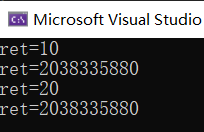
2.3 常量引用
目的:用来修饰形参,防止误操作。
int &ret=10; //错了!,引用本身需要一个合法的内存空间。
1
/*
相当于编译器先创建一个临时变量:int temp=10;
然后进行起别名:int& ret=temp;
*/
const int& ret = 10;
12345
🔴注意:用常量引用之后不可以更改数据。
//eg.
int main()
{
const int& ret = 10;
ret = 100;//err
cout << "ret=" << ret << endl;
return 0;
}
12345678

C++推荐引用,因为语法方便,编译器帮我们做了指针的内容。
三、函数提高
3.1 函数默认参数
语法:返回类型 函数名 (参数 =默认值) {}
用法:如果自己传入数据就用自己的,如果没有就用默认值。
int Add(int a = 0, int b = 0)
{
return a + b;
}
int main()
{
int a = 10;
int b = 20;
int c = Add(a, b);
int e = Add(a);
int f = Add(b);
int g = Add();
cout << "c=" << c << endl;
cout << "e=" << e << endl;
cout << "f=" << f << endl;
cout << "g=" << g << endl;
return 0;
}
123456789101112131415161718

🔴注意:
①默认值必须放在右边。
int test(int a, int b = 10, int c);//err
1
②声明和实现,有且只能有一个有默认参数。否则可能出现二义。
3.2 函数占位参数
语法:返回类型 函数名 (数据类型) {}
//eg.
void test1(int a, int)
{
cout << "haha" << endl;
}
void test2(int a, int b=10)//占位参数可以有默认参数
{
cout << "haha" << endl;
}
int main()
{
test1(1);//err
test1(1, 1);
test2(1);
test2(1, 1);
return 0;
}
12345678910111213141516171819
3.3 函数重载
作用:函数名可以相同,提高复用率。
满足条件:
①同一个作用域。
②函数名称相同。
③参数类型不同/个数不同/顺序不同。
//eg.
//在全局作用域
void test()
{
cout << "调用test( )" << endl;
}
void test(int a)
{
cout << "调用test(int a)" << endl;
}
void test(double a)
{
cout << "调用test(double a)" << endl;
}
void test(int a, int b)
{
cout << "调用test(int a, int b)" << endl;
}
void test(int a, double b)
{
cout << "调用test(int a, double b)" << endl;
}
void test(double a, int b)
{
cout << "调用test(double a, int b)" << endl;
}
int main()
{
test();
test(1);
test(3.14);
test(1,3.14);
test(3.14, 1);
return 0;
}
1234567891011121314151617181920212223242526272829303132333435

🔴注意:
①函数的返回值不可以作为函数重载的条件!出现二义。
//eg.
void test(int a)
{
cout << "调用test(int a)" << endl;
}
int test(int a)
{
cout << "调用test(int a)" << endl;
}
123456789

②引用作为重载条件
//eg.
//引用作为重载条件
void test(int &a)
{
cout << "调用test(int &a)" << endl;
}
void test(const int& b)
{
cout << "调用test(const int& b)" << endl;
}
int main()
{
int a = 10;
const int b = 10;
test(a);
test(b);
return 0;
}
123456789101112131415161718

③函数重载碰到默认参数
//eg.
//函数重载碰到默认参数
void test(int a,int b=10)
{
cout << "调用test(int &a)" << endl;
}
void test(int a)
{
cout << "调用test(const int& b)" << endl;
}
int main()
{
test(10);//err,出现二义
return 0;
}
123456789101112131415

四、类与对象
C++面向对象三大特性:封装、继承、多态
4.1 封装
🟦意义:
①将属性和行为作为一个整体。(放在一个class里面)
②将属性和行为加以权限控制。
public公共权限:类内外都可以访问
protected保护权限: 类外不可以访问
private私有权限: 类外不可以访问
//eg.1定义一个圆类
#define PI 3.14
//class 定义一个类 circle是类的名字
class circle
{
//访问权限:公共权限
public:
//属性
int r;
//行为
double circumference( )
{
return r * PI * 2;
}
};
int main()
{
circle c1;//创建具体的圆(对象)(实例化)
c1.r = 10;//给具体的圆的属性赋值
cout << "圆的周长为:" << c1.circumference() << endl;
return 0;
}
12345678910111213141516171819202122
//eg.2设计一个学生类
class student
{
public:
//属性
string name;//string 类处理起字符串来会方便很多,完全可以代替C语言中的字符数组或字符串指针。
int id;
//行为
void show() {
cout << "姓名:" << name << "学号:" << id << endl;
}
};
int main()
{
student s1;
s1.name = "xiyang";
s1.id = 1;
s1.show();
return 0;
}
1234567891011121314151617181920
//eg.3 公共权限,私有权限,保护权限访问的例子
class person
{
public:
string name;
protected:
string car;
private:
int password;
public:
void test()
{
name = "zyz";
car = "ofo";
password = 123;
}
};
int main()
{
person p1;
p1.name = "xiyang";
p1.car = "ufo"; //err
p1.password = 456;//err
return 0;
}
12345678910111213141516171819202122232425
🔴注意:
struct与class的区别:
struct默认权限为:共有
class默认权限为:私有
4.1.1 成员属性设置为私有
🟦意义:
①可以直接控制读写的权限。
②对于写可以检测数据的有效性。
//eg.
class person
{
private:
string name;//可读写
int age;//只读
string lover;//只写
public:
void SetName(string s)
{
name = s;
}
string GetName()
{
return name;
}
int GetAge()
{
age = 18;
return age;
}
void SetLover(string s)
{
lover = s;
}
};
int main()
{
person p1;
p1.SetName("xiyang");
p1.SetLover("薇尔莉特·伊芙加登");
cout << "姓名为:" << p1.GetName() << endl;
cout << "年龄为:" << p1.GetAge() << endl;
return 0;
}
1234567891011121314151617181920212223242526272829303132333435
设计案例1:立方体类
/*
要求:
1.设计一个立方体类
2.求出立方体的面积和体积
3.分别用全局函数和成员函数判断两个立方体是否相等
*/
class cube
{
private:
//属性
int L;
int W;
int H;
public:
//行为
//设置 获取长,宽,高
void SetL(int a)
{
L = a;
}
int GetL()
{
return L;
}
void SetW(int a)
{
W = a;
}
int GetW()
{
return W;
}
void SetH(int a)
{
H = a;
}
int GetH()
{
return H;
}
//获得面积
int S()
{
return 2 * ((L * W) + (L * H) + (W * H));
}
//获得体积
int V()
{
return L * W * H;
}
//成员函数判断
bool isSameByClass(cube& c)
{
if (c.GetL() == L && c.GetW() ==W && c.GetH() == H)
return true;
else
return false;
}
};
//全局函数判断
bool isSame(cube& c1, cube& c2)
{
if (c1.GetL() == c2.GetL() && c1.GetW() == c2.GetW() && c1.GetH() == c2.GetH())
return true;
else
return false;
}
int main()
{
cube c1,c2;
c1.SetL(10);
c1.SetW(10);
c1.SetH(10);
c2.SetL(10);
c2.SetW(5);
c2.SetH(5);
cout << "第一个立方体的面积为:" << c1.S() << endl;
cout << "第一个立方体的体积为:" << c1.V() << endl;
bool ret1 = isSame(c1, c2);
if (ret1)
{
cout << "全局函数判断c1 c2相等" << endl;
}
else
cout << "全局函数判断c1 c2不相等" << endl;
bool ret2 = c1.isSameByClass(c2);
if (ret2)
{
cout << "成员函数判断c1 c2相等" << endl;
}
else
cout << "成员函数判断c1 c2不相等" << endl;
return 0;
}
12345678910111213141516171819202122232425262728293031323334353637383940414243444546474849505152535455565758596061626364656667686970717273747576777879808182838485868788899091929394959697

设计案例2:点和圆的关系
/*要求:
1.设计一个圆形类和一个点类
2.计算点和圆的关系
*/
//由简单的数学可知:一个点(x,y)和圆的(x,y,r)的关系有三种:
//1.点在圆内:点到圆心的距离d < r
//2.点在圆上:d=r
//3.点在圆外:d>r
class circle
{
private:
int r;//写+读
int x;//写+读
int y;//写+读
public:
void SetX(int a)
{
x = a;
}
int GetX()
{
return x;
}
void SetY(int a)
{
y = a;
}
int GetY()
{
return y;
}
void SetR(int a)
{
r = a;
}
int GetR()
{
return r;
}
};
class point
{
private:
int x;//写
int y;//写
public:
void SetX(int a)
{
x = a;
}
void SetY(int a)
{
y = a;
}
int location(circle& c)
{
if ((x - c.GetX()) * (x - c.GetX()) + (y - c.GetY()) * (y - c.GetY()) == c.GetR() * c.GetR())
return 0;
else if ((x - c.GetX()) * (x - c.GetX()) + (y - c.GetY()) * (y - c.GetY()) > c.GetR() * c.GetR())
return 1;
else
return -1;
}
};
int main()
{
circle c;
point p;
c.SetX(0);
c.SetY(0);
c.SetR(1);
p.SetX(0);
p.SetY(0);
int ret = p.location(c);
if (ret == 1)
{
cout << "点在圆外" << endl;
}
else if(ret == -1)
{
cout << "点在圆内" << endl;
}
else
{
cout << "点在圆上" << endl;
}
return 0;
}
1234567891011121314151617181920212223242526272829303132333435363738394041424344454647484950515253545556575859606162636465666768697071727374757677787980818283848586878889
优化:因为圆类里面包含点类(转到目录4.3.2.4类对象作为类的成员)
4.2 对象的初始化和清理
C++利用构造函数和析构函数解决了对象的初始化和清理。对象的初始化和清理工作是编译器强制要求我们做的事情,因此就算我们不提供构造和析构,编译器也会提供,只不过编译器提供的是构造函数和析构函数的空实现。
4.3.1 构造函数
定义:主要作用在创建对象时为对象的成员属性赋值,构造函数由编译器自动调用,无须手动调用。
语法:类名 () { }
分类:按参数分:有参,无参;按类型分:普通构造,拷贝构造。
调用方式:括号法,显示法,隐式转换法.
🔴注意:
①构造函数可以有参数,因此可以重载。
②程序在调用对象时会自动调用构造,无须手动调用,且只用调用一次。
//构造的分类和调用
class person
{
public:
//无参(普通构造)(默认构造)
person()
{
cout << "无参构造函数调用" << endl;
}
//有参(普通构造)
person(int a)
{
cout << "有参构造函数调用" << endl;
}
//拷贝构造函数
person(const person &p)
{
age = p.age;//克隆数据
cout << "拷贝构造函数的调用" << endl;
}
public:
int age;
};
int main()
{
//括号法
person p1;//叫括号法,但是不能加(),加了()编译器会认为是一个函数声明
person p2(10); //p2的年龄初始化为10
person p3(p2);
//显示法
person p4 = person();
person p5 = person(10);
person p6 = person(p5);
//person()为匿名对象,没有名字,但创建了对象
//不要用拷贝构造函数初始化匿名对象,如person(p3),等价于person p3
//隐式转换法
person p7 = 10;//转换为:person p7=person(10)
}
12345678910111213141516171819202122232425262728293031323334353637383940
构造函数的调用规则:
创建一个类,C++至少给每一个类添加4个函数:默认构造(空实现),析构函数(空实现),拷贝构造(值拷贝),赋值运算符Operator=对属性进行值拷贝(4.5.4中介绍)
①如果用户定义一个有参构造函数,C++不会提供默认构造函数,但是会提供拷贝构造函数。
②如果用户定义一个拷贝构造函数,C++不会提供别的构造函数。
//eg.①如果用户定义一个有参构造函数,C++不会提供默认构造函数,但是会提供拷贝构造函数
class person
{
public:
person(int a)
{
age = a;
cout << "默认构造函数的调用" << endl;
}
int show()
{
return age;
}
private:
int age;
};
int main()
{
person p1;//err
person p2(18);
person p3(p2);//拷贝构造函数
cout << "p2的年龄为:" << p2.show() << endl;
return 0;
}
123456789101112131415161718192021222324
//②如果用户定义一个拷贝构造函数,C++不会提供别的构造函数
class person
{
public:
person(const person& p)
{
age = p.age;//克隆数据
cout << "拷贝构造函数的调用" << endl;
}
int show()
{
return age;
}
private:
int age;
};
int main()
{
person p1;//err
person p2(18);//err
person p3(p1);
cout << "p2的年龄为:" << p2.show() << endl;
return 0;
}
123456789101112131415161718192021222324
4.3.2 析构函数
定义:主要作用在于对象销毁前系统自动调用,执行一些清理工作。
语法:~类名 () { }
🔴注意:
①析构函数不可以有参数,因此不可以重载。
②程序在对象销毁前会自动调用析构,无须手动调用,且只用调用一次。
//eg. 构造函数和析构函数例子
class person
{
public:
person()
{
cout << "构造函数的调用" << endl;
}
~person()
{
cout << "析构函数的调用" << endl;
}
};
int main()
{
person p;//创建在栈上,在对象销毁前自动调用析构函数
return 0;
}
123456789101112131415161718

4.3.2.1 拷贝函数调用的时机
C++中拷贝函数调用一般有三种情况:
①使用一个已创建完毕的对象来初始化一个新对象。
②值传递的方式给函数参数传值。
③以值的方式返回局部对象。
class person
{
public:
person()
{
cout << "默认构造函数的调用" << endl;
}
person(int a)
{
age = a;
cout << "默认构造函数的调用" << endl;
}
person(const person& p)
{
age = p.age;//克隆数据
cout << "拷贝构造函数的调用" << endl;
}
int show()
{
return age;
}
private:
int age;
};
void test1(person p)//仅仅测试
{
}
person test2()
{
person p;
return p;
}
int main()
{
//使用一个已创建完毕的对象来初始化一个新对象
person p1(20);
person p2(p1);
cout << "p2的年龄为:" << p2.show() << endl;
//值传递的方式给函数参数传值
person p3;
test1(p3);
//以值的方式返回局部对象
test2();
return 0;
}
123456789101112131415161718192021222324252627282930313233343536373839404142434445
4.3.2.2 深拷贝与浅拷贝
- 浅拷贝:简单的赋值拷贝。
- 深拷贝:在堆区重新申请空间,进行拷贝。
❗ 浅拷贝存在的问题:堆区内容重复释放。

✅解决方案·

//eg.
class person
{
public:
person(int a,int h)
{
age = a;
height = new int(h);
cout << "有参构造函数的调用" << endl;
}
person(const person& p)
{
age = p.age;
//height=p.height;//编译器默认实现
height = new int(*(p.height));
cout << "拷贝构造函数的调用" << endl;
}
~person()
{
if (height != NULL)
{
delete height;
height = NULL;
}
cout << "析构函数的调用" << endl;
}
int GetAge()
{
return age;
}
int GetHeight()
{
return *height;
}
private:
int age;
int *height;
};
int main()
{
person p1(18, 160);
cout << "p1的年龄为:" << p1.GetAge() << " p1的身高为:" << p1.GetHeight() << endl;
person p2(p1);
cout << "p2的年龄为:" << p2.GetAge() << " p2的身高为:" << p2.GetHeight() << endl;
return 0;
}
12345678910111213141516171819202122232425262728293031323334353637383940414243444546
4.3.3 初始化列表
//eg.
class person
{
public:
//初始化列表初始化属性
person() :age(10), key(123), height(160)
{
}
person(int a, int b, int c) :age(a), key(b), height(c)
{
}
int age;
int key;
int height;
};
int main()
{
person p1;
person p2(18, 456, 180);
cout << "p1的年龄,密码,身高为:\n" << p1.age << p1.key << p1.height<<endl;
cout << "p2的年龄,密码,身高为:\n" << p2.age << p2.key << p2.height<<endl;
return 0;
}
12345678910111213141516171819202122232425
4.3.4 类对象作为类的成员
//eg.
class phone
{
public:
phone(string p):PhoneName(p)
{
}
string PhoneName;
};
class person
{
public:
person(string s,string p) : name(s),Phone(p)
{
}
string name;
phone Phone;
};
int main()
{
person p1("xiyang", "huawei");
cout << "名字:" << p1.name << "手机:" << p1.Phone.PhoneName << endl;
return 0;
}
123456789101112131415161718192021222324252627
🔴注意:若class里面有其他类,则先构造其他类,再构造自身。析构相反。
//eg
class phone
{
public:
phone(string p):PhoneName(p)
{
cout << "调用phone构造" << endl;
}
~phone()
{
cout << "调用phone析构" << endl;
}
string PhoneName;
};
class person
{
public:
person(string s,string p) : name(s),Phone(p)
{
cout << "调用person构造" << endl;
}
~person()
{
cout << "调用person析构" << endl;
}
string name;
phone Phone;
};
int main()
{
person p1("xiyang", "huawei");
cout << "名字:" << p1.name << "手机:" << p1.Phone.PhoneName << endl;
return 0;
}
1234567891011121314151617181920212223242526272829303132333435

4.3.5 静态成员
- 静态成员变量:
🔵特点:
①所有对象共享一份数据。
②在编译阶段分配内存。
③类内声明,类外初始化。
//eg.
class person
{
public:
static int a;//类内声明
};
int person::a = 100;//类外初始化
int main()
{
person p1;
cout << "p1的值为:" << p1.a << endl;
person p2;
p2.a = 200;
cout << "p1的值为:" << p1.a << endl;
return 0;
}
12345678910111213141516
🔴注意:
① 静态成员变量不属于某一个对象。因此有两种访问方式:①类名访问,②对象访问。
class person
{
public:
static int a;
};
int person::a = 100;
int main()
{
//对象访问
person p1;
cout << p1.a << endl;
//类名访问
cout << person::a << endl;
return 0;
}
123456789101112131415
②静态成员变量也有访问权限。
- 静态成员函数:
🔵特点:
①所有对象共享一个函数。
②静态成员函数只能访问静态成员函数。
🔴注意:静态成员函数也有访问权限。
//静态成员函数的访问
class person
{
public:
static void test()
{
cout << "static void test()调用" << endl;
}
};
int main()
{
//对象访问
person p;
p.test();
//成员访问
person::test();
return 0;
}
123456789101112131415161718
//静态成员函数只能访问静态成员函数
class person
{
public:
static void test()
{
a = 200;
b = 200;//err,对象不明
cout << "static void test()调用" << endl;
}
static int a;//静态成员函数访问静态成员变量
int b;//非静态成员函数
};
int person::a = 100;
int main()
{
person p;
p.test();
return 0;
}
1234567891011121314151617181920
4.3 C++对象模型和this指针
4.4.1 成员变量和成员函数分开存储
在C++中,类的成员变量和成员函数分开存储,只有非静态成员变量才属于类的对象上。
//eg.
class person1
{
};
class person2
{
int a;//非静态成员变量
};
class person3
{
int a;
static int b;//静态成员变量
};
class person4
{
int a;
static int b;//静态成员变量
void test()//非静态成员函数
{
}
};
int main()
{
//空对象占用内存是 1
//C++会给每一个空对象分配一个字节的内存空间,为了区分空对象占内存的位置
//每一个空对象也应该有一个独一无二的内存地址
person1 p1;
cout << "sizeof(p)=" << sizeof(p1) << endl;//1
//虽然空对象有一个字节,但是一旦类里面不为空就跟着类中字节走
person2 p2;
cout << "sizeof(p)=" << sizeof(p2) << endl;//4
//静态成员变量不属于类对象上的
person3 p3;
cout << "sizeof(p)=" << sizeof(p3) << endl;//4
//类的成员变量和成员函数分开存储
person4 p4;
cout << "sizeof(p)=" << sizeof(p4) << endl;//4
return 0;
}
1234567891011121314151617181920212223242526272829303132333435363738394041424344
4.4.2 this指针概念
定义:this指针指向被调用的成员函数所属的对象。
🔵特点:
①this指针隐含在每一个非静态成员函数内的一种指针。
②this指针不需要定义,可直接使用。
🟦意义:
①当形参和成员变量同名时,可以用this指针来区分。
②在类的非静态成员函数中返回对象本身,可以用retrun *this
❗形参和成员变量名字相同:
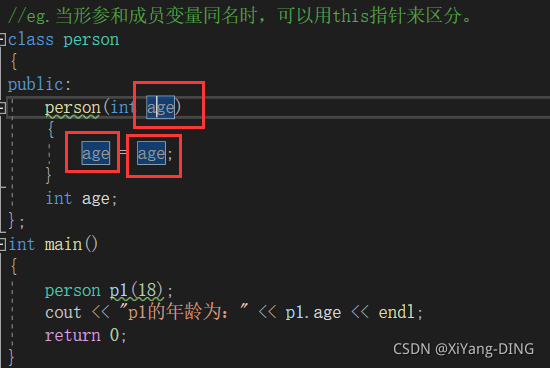
✅解决方案:
//eg.当形参和成员变量同名时,可以用this指针来区分。
class person
{
public:
person(int age)
{
//this 指向被调用的成员函数所属的对象
this->age = age;
}
int age;
};
int main()
{
person p1(18);
cout << "p1的年龄为:" << p1.age << endl;
return 0;
}
123456789101112131415161718

// 在类的非静态成员函数中返回对象本身,可以用retrun *this
class person
{
public:
person(int age)
{
this->age = age;
}
person& test(person p)//person一定要加&,使用本体
{
this->age += p.age;
return *this;
}
int age;
};
int main()
{
person p1(18);
person p2(18);
//链式编程
p2.test(p1).test(p1);
cout << "p2的年龄为:" << p2.age << endl;
return 0;
}
123456789101112131415161718192021222324
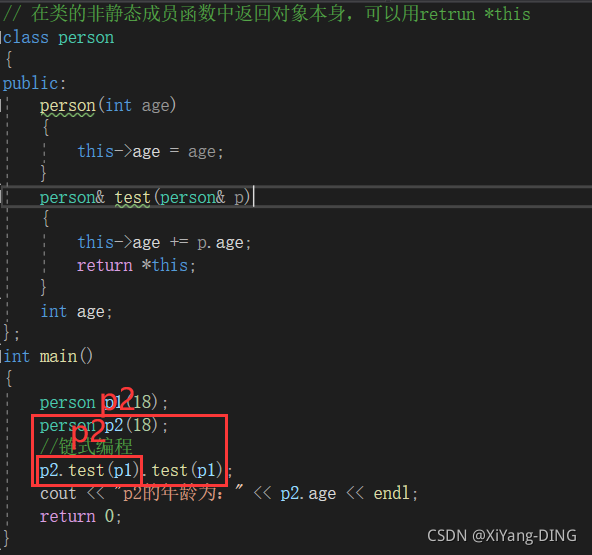
4.4.3 空指针访问成员函数
C++中空指针可以调用成员函数
class person
{
public:
void test1()
{
cout << "test1" << endl;
}
void test2()
{
cout << "age="<<this->age<< endl;//err,传入的指针为空
}
int age;
};
int main()
{
person *p=NULL;
p->test1();
p->test2();
return 0;
}
1234567891011121314151617181920
void test2()
{
if(this->age==NULL)
return;//提高代码的健壮性
cout << "age="<<this->age<< endl;//err,传入的指针为空
}
123456
4.4.4 const修饰成员函数
常函数:成员函数后const
🔵特点:
①常函数内不可以修改成员属性。
②成员属性声明时加关键字mutable后,在常函数中依然可以修改。
//eg.
class person
{
void test2()
{
a = 100;
b = 200; //err b是常量不可以修改
c = 300;
}
//在成员函数后加const,修饰的是this指向,让指针指向的值不能改变
void test1() const
{
a = 100; //err 相当于this->a=100
b = 200; //err b是常量不可修改
c = 300;
}
int a;
const int b;
mutable int c;
};
int main()
{
person p;
p.test1();
p.test2();
return 0;
}
123456789101112131415161718192021222324252627
常对象:声明对象前加const
🔵特点:
①常对象只能调用常函数。
//eg.
class person
{
public:
void test1()
{
}
void test2() const
{
}
int a;
const int b;
mutable int c;
};
int main()
{
const person p;//不能修改指针指向的值
p.a = 100;//err
p.b = 200;//err
p.c = 300;
p.test1();//err 常对象只能调用常函数
p.test2();
}
1234567891011121314151617181920212223
4.4 友元
目的:让一个函数或类,访问另一个类中的私有成员。
关键字:friend
实现:
①全局函数做友元。
②类做友元。
③成员函数做友元。
//全局函数做友元
class building
{
friend void test2(building* b);//声明友元函数
private:
string bedroom;
public:
building()
{
bedroom = "卧室";
livingroom = "客厅";
}
string livingroom;
};
void test1(building* b)
{
cout << "访问" << b->livingroom << endl;
cout << "访问" << b->bedroom<< endl;//err 不可访问私有成员
}
void test2(building* b)
{
cout << "访问" << b->livingroom << endl;
cout << "访问" << b->bedroom << endl;
}
int main()
{
building b1;
test1(&b1);
test2(&b1);
return 0;
}
12345678910111213141516171819202122232425262728293031
//类做友元
class building
{
friend class gay2;
public:
building();
string livingroom;
private:
string bedroom;
};
building::building()
{
bedroom = "卧室";
livingroom = "客厅";
}
//非友元
class gay1
{
public:
gay1();
void vist();
building* b;
};
gay1::gay1()
{
b = new building;
}
void gay1::vist()
{
cout << "朋友在访问" << b->livingroom << endl;
cout<< "朋友在访问" << b->bedroom << endl;//err 没有访问权限
}
//友元
class gay2
{
public:
gay2();
void vist();
building* b;
};
gay2::gay2()
{
b = new building;
}
void gay2::vist()
{
cout << "朋友在访问" << b->livingroom << endl;
cout << "朋友在访问" << b->bedroom << endl;
}
int main()
{
gay1 g1;
g1.vist();
gay2 g2;
g2.vist();
return 0;
}
123456789101112131415161718192021222324252627282930313233343536373839404142434445464748495051525354555657
//成员函数做友元
class building;//当用到友元成员函数时,需注意友元声明与友元定义之间的互相依赖。
class gay
{
public:
gay();
void test1();
void test2();
building* b;
};
gay::gay()
{
b = new building;
}
void gay::test1()
{
cout << "正在访问" << b->livingroom <<endl;
cout << "正在访问" << b->bedroom << endl;//err
}
void gay::test2()
{
cout << "正在访问" << b->livingroom << endl;
cout << "正在访问" << b->bedroom << endl;
}
class building
{
public:
building();
string livingroom;
friend void gay::test2();
private:
string bedroom;
};
building::building()
{
bedroom = "卧室";
livingroom = "客厅";
}
int main()
{
gay g1;
g1.test1();
g1.test2();
return 0;
}
12345678910111213141516171819202122232425262728293031323334353637383940414243444546
4.5 运算符重载
运算符重载对已有的运算符重新定义,赋予另一种功能,以适应不同的数据类型。
4.5.1 加号运算符重载
作用:实现两个自定义数据类型相加的运算。
//eg.
//加号运算符重载
class person
{
public:
person(int x, int y) :a(x), b(y)
{
}
//重载运算符operator
//成员函数重载+号
person operator+(person& p)
{
person temp(0, 0);
temp.a = this->a + p.a;
temp.b = this->b + p.b;
return temp;
}
int a;
int b;
};
//全局函数重载+号
person operator+(person& p1, person& p2)
{
person temp(0, 0);
temp.a = p1.a + p2.a;
temp.b = p1.b + p2.b;
return temp;
}
int main()
{
person p1(10, 10);
person p2(10, 10);
person p3 = p1+p2;//方法一(若用此方法需要屏蔽上面一种重载方式,避免多个运算符+与操作数匹配)
person p3 = p1.operator+(p2);//方法二
person p3 = operator+(p1, p2);//方法三
}
12345678910111213141516171819202122232425262728293031323334353637
🔴注意:不要滥用运算重载符。
4.5.2 左移运算符重载
作用:可以输出自定义类型。
//eg
class person
{
public:
//舍弃成员函数重载,p.operator<<cout相当于p<<cout与期望不相符
//void operator<<(cout)
//{
//}
person(int x) :a(x)
{
}
int a;
int b;
};
//全局函数重载左移运算符
//cout属于标准输出流ostream类型
//返回ostream是链式编程思想,返回后cout<<p<<...后面可以再利用
ostream& operator<<(ostream& cout, person& p)
{
cout <<"p中a的值为:"<< p.a<<"p中b的值为:"<< p.b<<endl;
return cout;
}
int main()
{
person p(10);
cout << p;//方法一
operator<<(cout, p);//方法二
return 0;
}
12345678910111213141516171819202122232425262728293031
4.5.3 递增运算符重载
//重载递增运算符
class MyInt
{
friend ostream& operator<<(ostream& cout, MyInt m);
public:
MyInt()
{
num = 0;
}
//前置++
//&的作用是对同一个数据进行递增
MyInt& operator++()
{
//先++
num++;
//再返回
return *this;
}
//后置++
//int是占位参数
MyInt operator++(int)
{
//先暂存
MyInt temp = *this;
//再++
num++;
//返回暂存的数据
return temp;
}
private:
int num;
};
ostream& operator<<(ostream& cout, MyInt m)
{
cout << m.num;
return cout;
}
int main()
{
MyInt m;
cout << ++m << endl;
cout <<m++<< endl;
return 0;
}
12345678910111213141516171819202122232425262728293031323334353637383940414243444546
🔴注意:前置++,返回是引用。后置++,返回的是值。
4.5.4 赋值运算符重载
创建一个类,C++至少给每一个类添加4个函数:默认构造(空实现),析构函数(空实现),拷贝构造(值拷贝),赋值运算符Operator=对属性进行值拷贝
//赋值运算符的重载
class person
{
public:
person(int a)
{
age=new int(a);
}
~person()
{
if (age != NULL)
{
delete age;
age = NULL;
}
}
//重载赋值运算符以避免浅拷贝带来的问题
person& operator=(person& p)
{
//age=p.age;//编译器默认实现
if (age != NULL)
{
delete age;
age = NULL;
}
age = new int(*p.age);
//返回自身
return *this;
}
int *age;
};
int main()
{
person p1(10);
person p2(20);
person p3(30);
p3=p2 = p1;
cout << *(p2.age) << endl;//10
cout << *(p3.age) << endl;//10
return 0;
}
1234567891011121314151617181920212223242526272829303132333435363738394041
4.5.5 关系运算符重载
作用:重载关系运算符,可以让两个自定义类型对象进行对比操作。
//关系运算符重载 == !=
class person
{
public:
person(string s,int a):name(s),age(a)
{
}
bool operator==(person& p)
{
if (this->name == p.name && this->age == p.age)
{
return true;
}
else
return false;
}
string name;
int age;
};
int main()
{
person p1("xi",10);
person p2("xi",20);
if (p1 == p2)
{
cout << "p1和p2相等" << endl;
}
else
cout << "p1和p2不相等" << endl;
return 0;
}
1234567891011121314151617181920212223242526272829303132
4.5.6 函数调用运算符重载(仿函数)
//函数调用运算符重载
class MyPrint
{
public:
void operator()(string text)//与函数调用长得差不多,所以被称为仿函数
{
cout << text << endl;
}
};
void print(string text)
{
cout << text << endl;
}
int main()
{
MyPrint m1,m2;
m1("xiyang");
m2("xiyang");
return 0;
}
1234567891011121314151617181920
4.6 继承
4.6.1 继承的基本语法
例如我们看到很多网站中,都有公共的头部,公共的底部,甚至公共的左侧列表,只有中心内容不同。接下来我们分别利用普通写法和继承的写法来实现网页中的内容,看一下继承存在的意义以及好处。
//普通实现页面
class java
{
public:
void head()
{
cout << "首页、公开课、登录、注册...(公共头部)" << endl;
}
void foot()
{
cout << "帮助中心、交流合作、站内地图...(公共底部)" << endl;
}
void left()
{
cout << "Java,Python,C++...(公共分类列表)" << endl;
}
void content()
{
cout << "JAVA学科视频" << endl;
}
};
class cpp
{
public:
void head()
{
cout << "首页、公开课、登录、注册...(公共头部)" << endl;
}
void foot()
{
cout << "帮助中心、交流合作、站内地图...(公共底部)" << endl;
}
void left()
{
cout << "Java,Python,C++...(公共分类列表)" << endl;
}
void content()
{
cout << "CPP学科视频" << endl;
}
};
class python
{
public:
void head()
{
cout << "首页、公开课、登录、注册...(公共头部)" << endl;
}
void foot()
{
cout << "帮助中心、交流合作、站内地图...(公共底部)" << endl;
}
void left()
{
cout << "Java,Python,C++...(公共分类列表)" << endl;
}
void content()
{
cout << "python学科视频" << endl;
}
};
void test1()
{
cout << "java下载视频页面如下:" << endl;
java j;
j.head();
j.foot();
j.left();
j.content();
cout << "--------------------" << endl;
}
void test2()
{
cout << "cpp下载视频页面如下:" << endl;
cpp c;
c.head();
c.foot();
c.left();
c.content();
cout << "--------------------" << endl;
}
void test3()
{
cout << "python下载视频页面如下:" << endl;
python p;
p.head();
p.foot();
p.left();
p.content();
cout << "--------------------" << endl;
}
int main()
{
test1();
test2();
test3();
return 0;
}
123456789101112131415161718192021222324252627282930313233343536373839404142434445464748495051525354555657585960616263646566676869707172737475767778798081828384858687888990919293949596979899
//继承写法
class BasePage
{
public:
void head()
{
cout << "首页、公开课、登录、注册...(公共头部)" << endl;
}
void foot()
{
cout << "帮助中心、交流合作、站内地图...(公共底部)" << endl;
}
void left()
{
cout << "Java,Python,C++...(公共分类列表)" << endl;
}
void content()
{
cout << "python学科视频" << endl;
}
};
class java :public BasePage
{
void content()
{
cout << "java学科视频" << endl;
}
};
class cpp :public BasePage
{
void content()
{
cout << "cpp学科视频" << endl;
}
};
class python :public BasePage
{
void content()
{
cout << "python学科视频" << endl;
}
};
123456789101112131415161718192021222324252627282930313233343536373839404142
优势:减少重复代码
语法:class 子类 : 继承方式
4.6.2 继承方式
一共有三中继承方式: ①公共继承②保护继承③私有继承
//eg.
class father
{
public:
int a;
protected:
int b;
private:
int c;
};
//公共继承
class son1 :public father
{
public:
void test1()
{
a = 10;//父类中的公共权限成员,子类也是公共权限
b = 10;//父类中的保护权限成员,子类也是保护权限
//c = 10;//err 父类的私有权限成员,子类无法访问
}
};
void test11()
{
son1 s;
s.a;
//s.b;//err保护权限,类外无法访问
}
//保护继承
class son2 :protected father
{
public:
void test2()
{
a = 10;//父类中的公共权限成员,子类是保护权限
b = 10;//父类中的保护权限成员,子类是保护权限
//c = 10;//err 父类的私有权限成员,子类无法访问
}
};
void test22()
{
son2 s;
//s.a;//err保护权限,类外无法访问
//s.b;//err保护权限,类外无法访问
}
//私有继承
class son3 :private father
{
public:
void test3()
{
a = 10;//父类中的公共权限成员,子类是私有权限
b = 10;//父类中的保护权限成员,子类是私有权限
//c = 10;//err 父类的私有权限成员,子类无法访问
}
};
void test22()
{
son3 s;
//s.a;//err私有权限,类外无法访问
//s.b;//err私有权限,类外无法访问
}
12345678910111213141516171819202122232425262728293031323334353637383940414243444546474849505152535455565758596061626364
4.6.3 继承中的对象模型
❗ Q:从父类继承过来的成员,哪些属于子类对象中?
//eg
class father
{
public:
int a;
static int d;//不继承
protected:
int b;
private:
int c;
};
class son :public father
{
public:
int e;
};
int main()
{
//父类中的所有非静态成员属性都会被子类继承
//父类的私有成员被编译器隐藏,访问不到但是被继承
cout << "size of(son)=" << sizeof(son) << endl;//16
return 0;
}
1234567891011121314151617181920212223
用工具查看:

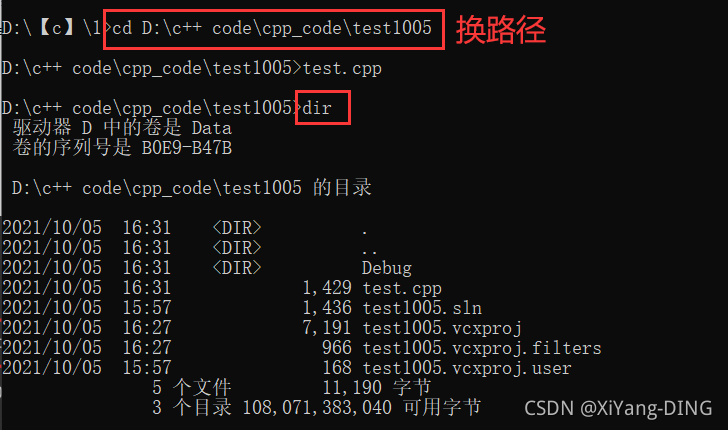
cl /d1 reportSingleClassLayout查看的类名 所属文件名
1

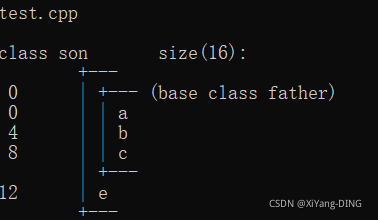
4.6.4 继承中构造和析构顺序
//eg
class father
{
public:
father()
{
cout << "father的构造函数" << endl;
}
~father()
{
cout << "father的析构函数" << endl;
}
};
class son :public father
{
public:
son()
{
cout << "son的构造函数" << endl;
}
~son()
{
cout << "son的析构函数" << endl;
}
};
int main()
{
son s;
return 0;
}
123456789101112131415161718192021222324252627282930

4.6.5 继承同名成员处理方式
//eg
class father
{
public:
father()
{
a = 10;
}
void test()
{
cout << "father中的test()函数调用" << endl;
}
int a;
static int b;
};
int father::b=10;
class son :public father
{
public:
son()
{
a = 20;
}
void test()
{
cout << "son中的test()函数调用" << endl;
}
int a;
static int b;
};
int son::b = 20;
int main()
{
son s;
//同名非静态属性处理方式
cout << "son中a=" << s.a << endl;
cout << "father中a=" << s.father::a << endl;//通过子类对象访问父类对象成员需要加作用域
//同名函数处理方式1hj
s.test();
s.father::test();
//同名静态属性处理方式
//方法一:对象访问
cout << "对象访问son中b=" << s.b << endl;
cout << "对象访问father中b=" << s.father::b << endl;
//方法二:类名访问
cout << "类名访问son中b = " << son::b << endl;
cout << "类名访问father中b = " << father::b << endl;
cout << "类名访问father中b = " << son::father::b << endl;
}
123456789101112131415161718192021222324252627282930313233343536373839404142434445464748495051
①子类对象访问子类同名成员:直接访问
②子类对象访问父类同名成员:加作用域::
4.6.6 多继承语法
语法:class 子类 :继承方式 父类1,继承方式 父类2,...
//eg .用法与上面的大同小异,多继承可能会引发父类中有同名成员出现,需要加作用域区分
class father1
{
public:
father1()
{
a = 10;
}
int a;
};
class father2
{
public:
father2()
{
b = 10;
}
int b;
};
class son :public father1, public father2
{
public:
son()
{
c = 10;
d = 20;
}
int c;
int d;
};
int main()
{
son s;
cout << "sizeof (son)=" << sizeof(son) << endl;
cout << "father1中a的值" << s.a << endl;
}
12345678910111213141516171819202122232425262728293031323334353637
🔴注意:C++实际开发中不建议用多继承
4.6.7 菱形继承
定义:两个派生类继承同一个基类,又有某个类同时继承者两个派生类。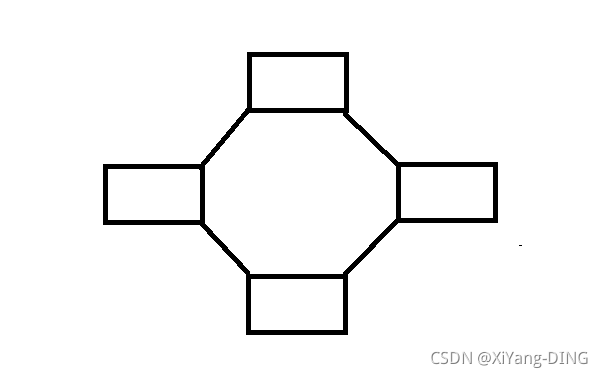
❗Q:菱形继承带来的主要问题是子类继承两份相同的数据,导致资源浪费以及毫无意义
✅:虚继承可以解决菱形继承问题
//eg.
class animal
{
public:
int age;
};
//关键字virtual将yang变成虚继承
class yang:virtual public animal{};
class tuo:virtual public animal{};
class YangTuo :public yang, public tuo{};
int main()
{
YangTuo yt;
yt.yang::age = 10;
yt.tuo::age = 20;
//数据只有一份
cout << yt.yang::age << endl;//20
cout << yt.tuo::age << endl;//20
cout << yt.age << endl;//20
}
1234567891011121314151617181920
4.7 多态
4.7.1 多态的基本概念
分类:
①静态多态:函数重载 和 运算符重载
①动态多态:派生类和虚函数实现运行时多态
🔵特点:
- 静态多态的函数地址早绑定 - 编译阶段确定函数地址
- 动态多态的函数地址晚绑定 - 运行阶段确定函数地址
//eg
class animal
{
public:
void breathe()
{
cout << "动物呼吸" << endl;
}
//虚函数
virtual void speak()
{
cout << "动物叫" << endl;
}
};
class cat:public animal
{
public:
void breathe()
{
cout << "喵呼吸" << endl;
}
//重写
void speak()
{
cout << "miaomiao~" << endl;
}
};
//地址早绑定 在编译阶段确定函数地址
void DoSpeak(animal &a)
{
a.speak();
}
//地址晚绑定 在函数前加 virtual,在运行阶段确定地址
void DoBreathe(animal& a)
{
a.breathe();
}
int main()
{
cat c;
DoSpeak(c);//miaomiao~
DoBreathe(c);//动物呼吸
}
1234567891011121314151617181920212223242526272829303132333435363738394041424344
动态多态满足条件:
①有继承关系
②子类重写父类中的虚函数(子类的virtual可有可无)
动态多态的使用:父类的指针或引用,执行子类对象。
4.7.2 多态原理剖析(图解)
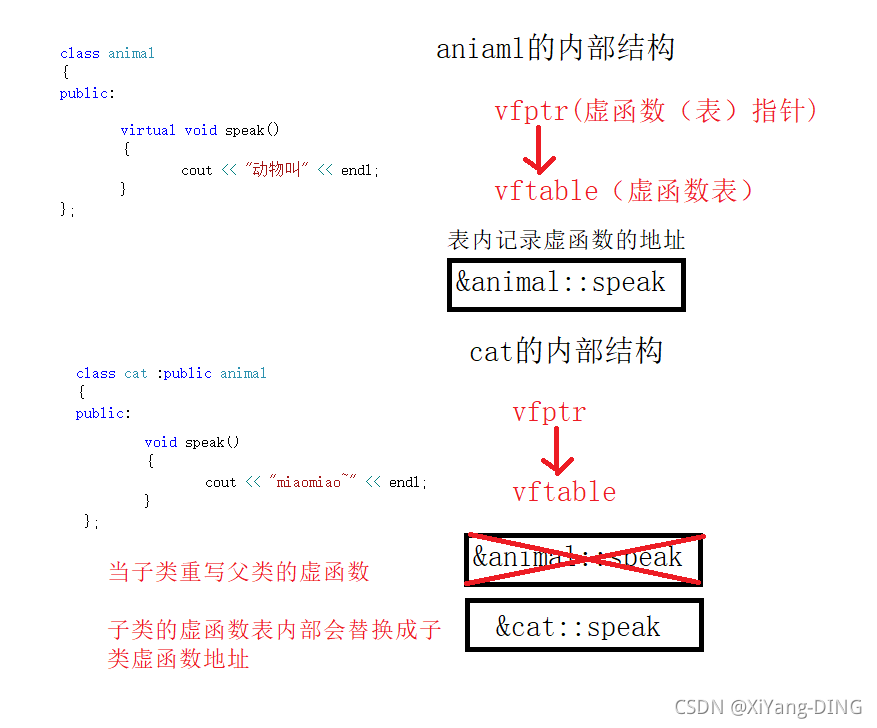
4.7.3 多态案例一:计算器类
案例描述:
分别利用普通写法和多态技术,设计实现两个操作数进行运算的计算器类
//普通写法 + - * /
class calculator
{
public:
int GetResult(string s)
{
if (s == "+")
return a + b;
else if (s == "-")
return a - b;
else if (s == "*")
return a * b;
else if (s == "/")
return a / b;
}
int a;
int b;
};
int main()
{
calculator c;
string s;
cout << "输入两个整型数字的+-*/运算:" << endl;;
cin >> c.a >>s>> c.b;
cout << "=" << c.GetResult(s) << endl;
return 0;
}
123456789101112131415161718192021222324252627
❗局限:扩展新的功能,需要修改源码。
✅:
//多态写法
class AbstractCalculator
{
public:
virtual int GetResult()
{
return 0;
}
int a;
int b;
};
//加法计算器类
class Add :public AbstractCalculator
{
public:
int GetResult()
{
return a + b;
}
};
//减法计算器类
class Sub :public AbstractCalculator
{
public:
int GetResult()
{
return a - b;
}
};
//乘法计算器类
class Mul :public AbstractCalculator
{
public:
int GetResult()
{
return a * b;
}
};
//除法计算器类
class Div:public AbstractCalculator
{
public:
int GetResult()
{
return a / b;
}
};
void Do(AbstractCalculator& ac2)
{
ac2.GetResult();
}
int main()
{
//加法
//父类的指针或引用,执行子类对象
AbstractCalculator* ac = new Add;
ac->a = 10;
ac->b = 20;
cout << ac->a << "+" << ac->b << "=" << ac->GetResult() << endl;
//记得销毁
delete ac;
//减法
ac = new Sub;
ac->a = 10;
ac->b = 20;
cout << ac->a << "-" << ac->b << "=" << ac->GetResult() << endl;
//记得销毁
delete ac;
//乘法除法同理
}
1234567891011121314151617181920212223242526272829303132333435363738394041424344454647484950515253545556575859606162636465666768697071727374
多态优势:
①组织结构清晰,可读性强。
②对于前期和后期扩展及维护性高。
4.7.4 纯虚函数和抽象类
在多态中,通常父类中虚函数的实现是毫无意义的,主要都是调用子类重写的内容,因此可以将虚函数改为纯虚函数
纯虚函数定义:virtual 返回值类型 函数名 (参数列表)= 0 ;
抽象类定义:当类中有了纯虚函数,这个类也称为抽象类
🔵抽象类的特点:
①无法实例化对象
②子类必须重写抽象类中的纯虚函数,否则也属于抽象类
class base
{
public:
//纯虚函数
virtual void func() = 0;
};
class son1 :public base
{
public:
};
class son2 :public base
{
public:
void func()
{}
};
int main()
{
//base b;//err 抽象类无法实例化对象
//new base;//err
//son1 s;//子类必须重写抽象类中的纯虚函数,否则也属于抽象类
son2 s;
}
123456789101112131415161718192021222324
4.7.5 多态案例二:制作饮品
案例描述:
制作饮品的大致流程为:煮水 - 冲泡 - 倒入杯中 - 加入辅料。
利用多态技术实现本案例,提供抽象制作饮品基类,提供子类制作咖啡和茶叶。
class AbstractDrinking
{
public:
//煮水
virtual void BoilWater() = 0;
//冲泡
virtual void Brew() = 0 ;
//倒入杯中
virtual void IntoCup() = 0;
//加入辅料
virtual void PutSomeing() = 0;
//制作饮品
void Make()
{
BoilWater();
Brew();
IntoCup();
PutSomeing();
}
};
class Tea :public AbstractDrinking
{
//煮水
virtual void BoilWater()
{
cout << "煮500ml水" << endl;
}
//冲泡
virtual void Brew()
{
cout << "加入10g茶叶" << endl;
}
//倒入杯中
virtual void IntoCup()
{
cout<<"倒入杯子里"<<endl;
}
//加入辅料
virtual void PutSomeing()
{
cout << "加入柠檬" << endl;
}
};
class Coffee :public AbstractDrinking
{
//煮水
virtual void BoilWater()
{
cout << "煮500ml水" << endl;
}
//冲泡
virtual void Brew()
{
cout << "加入一勺咖啡" << endl;
}
//倒入杯中
virtual void IntoCup()
{
cout << "倒入杯子里" << endl;
}
//加入辅料
virtual void PutSomeing()
{
cout << "加入牛奶" << endl;
}
};
void DoMake(AbstractDrinking* ad)
{
ad->Make();
delete ad;//记得销毁
}
int main()
{
//做一杯茶
DoMake(new Tea);
//做一杯咖啡
DoMake(new Coffee);
}
12345678910111213141516171819202122232425262728293031323334353637383940414243444546474849505152535455565758596061626364656667686970717273747576777879
4.7.6 虚析构函数和抽象类
多态使用时,如果子类中有属性开辟到堆区,那么父类指针在释放时无法调用到子类的析构代码,将父类中的析构函数改为虚析构或者纯虚析构就可以解决
虚析构语法:virtual ~类名(){}
纯虚析构语法:virtual ~类名() = 0; 类名::~类名(){}
class Animal
{
public:
Animal()
{
cout << "Animal构造函数的调用" << endl;
}
~Animal()
{
cout << "Animal析构函数的调用" << endl;
}
//虚析构可以解决 父类指针释放子类对象时不干净的问题
//virtual ~Animal()
//{
// cout << "Animal虚析构函数的调用" << endl;
//}
//纯虚析构
//virtual ~Animal() = 0;
virtual void speak() = 0;
};
//纯虚析构函数要有具体的函数实现
//Animal::~Animal()
//{
// cout << "Animal纯虚析构函数的调用" << endl;
//}
class Cat:public Animal
{
public:
Cat(string n)
{
cout << "Cat的构造函数的调用" << endl;
name = new string(n);
}
void speak()
{
cout << *name<<"miao~" << endl;
}
~Cat()
{
cout << "Cat的析构函数的调用" << endl;
if (name != NULL)
{
delete name;
name = NULL;
}
}
string *name;
};
int main()
{
Animal* a = new Cat("mimi");
a->speak();
//父类指针在析构时候,不会调用子类中的析构函数,导致子类如果有堆区的属性,会出现内存的泄露
delete a;
}
12345678910111213141516171819202122232425262728293031323334353637383940414243444546474849505152535455565758
虚析构和纯虚析构共性:
①可以解决父类指针释放子类对象
②都需要有具体的函数实现
🔴注意:纯虚析构,该类属于抽象类,无法实例化对象
4.7.7 多态案例三:电脑组装
案例描述:
电脑主要组成部件为 CPU(用于计算),显卡(用于显示),内存条(用于存储)
将每个零件封装出抽象基类,并且提供不同的厂商生产不同的零件,例如Intel厂商和Lenovo厂商
创建电脑类提供让电脑工作的函数,并且调用每个零件工作的接口
测试时组装三台不同的电脑进行工作
class CPU
{
public:
virtual void calulate() = 0;
};
class VideoCard
{
public:
virtual void display() = 0;
};
class Memory
{
public:
virtual void storage() = 0;
};
//intel 厂商
class IntelCPU :public CPU
{
void calulate()
{
cout << "Intel的CPU工作啦!" << endl;
}
};
class IntelVideoCard :public VideoCard
{
void display()
{
cout << "Intel的VideoCard工作啦!" << endl;
}
};
class IntelMemory :public Memory
{
void storage()
{
cout << "Intel的Memory工作啦!" << endl;
}
};
//XiaoMi厂商
class XiaoMiCPU :public CPU
{
void calulate()
{
cout << "XiaoMi的CPU工作啦!" << endl;
}
};
class XiaoMiVideoCard :public VideoCard
{
void display()
{
cout << "XiaoMi的VideoCard工作啦!" << endl;
}
};
class XiaoMiMemory :public Memory
{
void storage()
{
cout << "XiaoMi的Memory工作啦!" << endl;
}
};
class Computer
{
public:
Computer(CPU* cpu, VideoCard* videpcard, Memory* memory)
{
this->cpu = cpu;
this->videpcard = videpcard;
this->memory = memory;
}
void DoWork()
{
cpu->calulate();
videpcard->display();
memory->storage();
}
~Computer()
{
if (cpu!= NULL)
{
delete cpu;
cpu = NULL;
}
if (videpcard!= NULL)
{
delete videpcard;
videpcard = NULL;
}
if (memory!= NULL)
{
delete memory;
memory = NULL;
}
}
private:
CPU* cpu;
VideoCard* videpcard;
Memory* memory;
};
int main()
{
CPU* intel_cpu = new IntelCPU;
VideoCard* intel_vc = new IntelVideoCard;
Memory* intel_m = new IntelMemory;
Computer c1(intel_cpu, intel_vc, intel_m);
c1.DoWork();
CPU* xiaomi_cpu = new XiaoMiCPU;
VideoCard* xiaomi_vc = new XiaoMiVideoCard;
Memory* xiaomi_m = new XiaoMiMemory;
Computer c2(xiaomi_cpu, xiaomi_vc, xiaomi_m);
c2.DoWork();
}
123456789101112131415161718192021222324252627282930313233343536373839404142434445464748495051525354555657585960616263646566676869707172737475767778798081828384858687888990919293949596979899100101102103104105106107108109110111112

五、文件
5.1 文本文件
程序运行时产生的数据都属于临时数据,程序一旦运行结束都会被释放,通过文件可以将数据持久化
C++中对文件操作需要包含头文件< fstream >
文件类型分为两种:
①文本文件 - 文件以文本的ASCII码形式存储在计算机中
②二进制文件 - 文件以文本的二进制形式存储在计算机中,用户一般不能直接读懂它们
操作文件的三大类:
①ofstream:写操作
②ifstream: 读操作
③fstream : 读写操作
5.1.1 写文件
写文件步骤如下:
- 包含头文件:
#include <fstream> - 创建流对象:
ofstream ofs; - 打开文件:
ofs.open(“文件路径”,打开方式); - 写数据:
ofs << "写入的数据"; - 关闭文件:
ofs.close();
文件打开方式:
| 打开方式 | 解释 |
|---|---|
| ios::in | 为读文件而打开文件 |
| ios::out | 为写文件而打开文件 |
| ios::ate | 初始位置:文件尾 |
| ios::app | 追加方式写文件 |
| ios::trunc | 如果文件存在先删除,再创建 |
| ios::binary | 二进制方式 |
🔴注意:文件打开方式可以配合使用,利用|操作符。
//eg.
#include <fstream>
int main()
{
//1.头文件
//2.创建流对象
ofstream ofs;
//3.打开文件,方式为:为写
ofs.open("test.txt", ios::out);
//4.写数据
ofs << "姓名:张三" << endl;
ofs << "性别:男" << endl;
ofs << "年龄:18" << endl;
//5.关闭文件
ofs.close();
return 0;
}
1234567891011121314151617
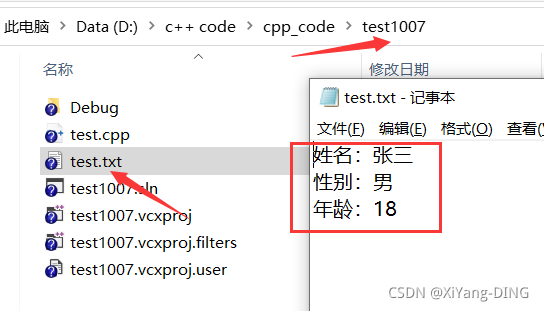
5.1.2 读文件
读文件步骤如下:
- 包含头文件:
#include <fstream> - 创建流对象:
ifstream ifs; - 打开文件并判断文件是否打开成功:
ifs.open(“文件路径”,打开方式); - 读数据: 四种方式读取
- 关闭文件:
ifs.close();
//eg.
#include <fstream>
#include <string>
void test()
{
//1.包含头文件
//2.创建流对象
ifstream ifs;
//3.打开文件并判断文件是否打开成功
ifs.open("test.txt", ios::in);
if (!ifs.is_open())
{
cout << "文件打开失败" << endl;
return;
}
//4.读数据
//第一种方式
char buf[1024] = { 0 };
while (ifs >> buf)
{
cout << buf << endl;
}
//第二种
char buf[1024] = { 0 };
while (ifs.getline(buf,sizeof(buf)))
{
cout << buf << endl;
}
//第三种
string buf;
while (getline(ifs, buf))
{
cout << buf << endl;
}
//第四种
char c;
while ((c = ifs.get()) != EOF)//end of file
{
cout << c;
}
//5.关闭文件
ifs.close();
}
int main()
{
test();
return 0;
}
1234567891011121314151617181920212223242526272829303132333435363738394041424344454647484950
5.2 二进制文件
以二进制的方式对文件进行读写操作打开方式要指定为 ios::binary
5.2.1 写文件
二进制方式写文件主要利用流对象调用成员函数write
函数原型 :ostream& write(const char * buffer,int len);
参数解释:字符指针buffer指向内存中一段存储空间。len是读写的字节数
#include <fstream>
#include <string>
class Person
{
public:
char m_Name[64];
int m_Age;
};
void test01()
{
//1、包含头文件
//2、创建输出流对象
ofstream ofs("person.txt", ios::out | ios::binary);
//3、打开文件
//ofs.open("person.txt", ios::out | ios::binary);
Person p = { "张三" , 18 };
//4、写文件
ofs.write((const char*)&p, sizeof(p));
//5、关闭文件
ofs.close();
}
int main()
{
test01();
return 0;
}
1234567891011121314151617181920212223242526
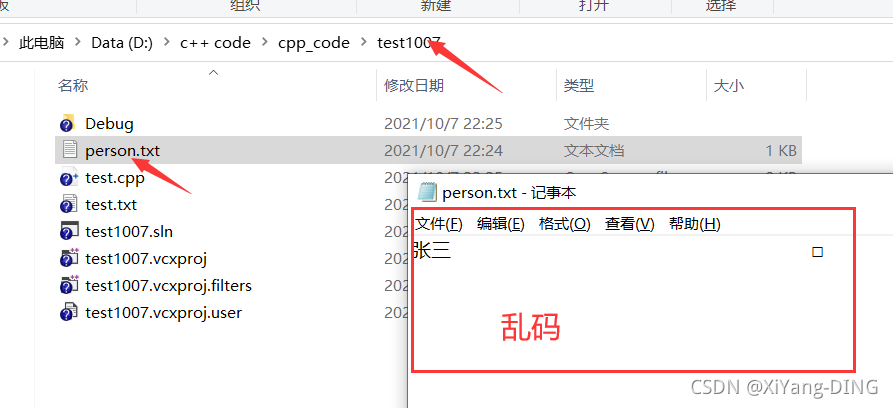
5.2.2 读文件
二进制方式读文件主要利用流对象调用成员函数read
函数原型:istream& read(char *buffer,int len);
参数解释:字符指针buffer指向内存中一段存储空间。len是读写的字节数
#include <fstream>
#include <string>
class Person
{
public:
char m_Name[64];
int m_Age;
};
void test01()
{
//1.包含头文件
//2.创建流对象
//3.打开文件并判断文件是否打开成功
ifstream ifs("person.txt", ios::in | ios::binary);
if (!ifs.is_open())
{
cout << "文件打开失败" << endl;
return;
}
//4.读文件(读到的是正常的不是乱码)
Person p;
ifs.read((char*)&p, sizeof(p));
cout << "姓名: " << p.m_Name << " 年龄: " << p.m_Age << endl;
//5.关闭文件
ifs.close();
}
int main()
{
test01();
return 0;
}
12345678910111213141516171819202122232425262728293031
文章知识点与官方知识档案匹配,可进一步学






